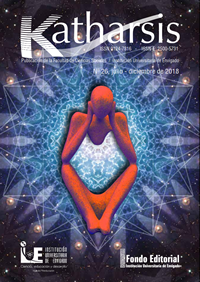Cognición corporeizada, situada y extendida: una revisión sistemática
DOI:
https://doi.org/10.25057/25005731.1100Resumen
Embodied, situated and extended cognition: a systematic review
Resumen
Artículo presenta resultado de una revisión en torno a tres perspectivas alternativas a la perspectiva tradicional de la cognición: la cognición corporeizada, la cognición situada y la cognición extendida, orientada a invitar a los investigadores en esta área (psicólogos, filósofos, antropólogos, educadores, neurocientíficos, entre otros) a considerar y estudiar formas alternas de encarar el fenómeno cognitivo. Para cada una de las tres perspectivas alternativas se exponen la teoría, los conceptos y algunos ejemplos de estudios empíricos que validan esas propuestas mediante una investigación bibliográfica sustentada en algunos de los principales libros y artículos en esta área. Este ejercicio analítico y hermenéutico estuvo ajustado a la metodología de la investigación documental.
Palabras clave: cognición corporeizada, cognición situada, cognición extendida.
Biografía del autor/a
Jorge Emiro Restrepo, Profesor Asistente. Facultad de Educación y Ciencias Sociales. Tecnológico de Antioquia, Institución Universitaria, Medellín, Colombia
Referencias bibliográficas
Adams, F., Aizawa, K. (2008). The bounds of cognition. Oxford: Blackwell Publishing.
Alibali, M. W., Nathan, M. J. (2012). Embodiment in Mathematics Teaching and Learning: Evidence From Learners’ and Teachers’ Gestures. Journal of the Learning Sciences, 21(2), 247-286. https://doi.org/10.1080/10508406.2011.611446
Ambrosini, E., Costantini, M. (2017). Body posture differentially impacts on visual attention towards tool, graspable, and non-graspable objects. Journal of Experimental Psycholo¬gy: Human Perception and Performance, 43(2), 360-370. http://dx.doi.org/10.1037/xhp0000330
Anderson, J. R. (2015). Cognitive Psychology and Its Implications. New York: Worth Publishers.
Baddeley, A. D., Woodhead, M. (1982). Depth of processing, context, and face recognition. Canadian Journal of Psychology/Revue canadienne de psychologie, 36(2), 148-164. http://dx.doi.org/10.1037/h0080635
Barsalou, L. W. (1999). Perceptual symbol systems. Behavioral and Brain Sciences, 22, 577–660. https://www.ncbi.nlm.nih.gov/pubmed/11301525
Barsalou, L. W. (2008). Grounded Cognition. Annual Review of Psychology, 59, 617–645.
Bartra, R. (2014). Antropología del cerebro. La conciencia y los sistemas simbólicos. México: Fondo de Cultura Económica.
Beer, R. D. (2014). Dynamical Systems and Embedded Cognition. En: K. Frankish y W. Ramsey (Eds.), The Cambridge Handbook of Artificial Intelligence (pp. 128-148). Cambridge University Press.
Bennett, M. R., Hacker, P. M. S. (2003). Philosophical Foundations of Neuroscience. Oxford: Blackwell.
Brighton., H., Todd, P. M. (2009). Situating Rationality. Ecologically Rational Decision Ma¬king with Simple Heuristics. En: P. Robbins & M. Aydede (Eds.), The Cambridge Han¬dbook of Situated Cognition (pp. 322-350). Cambridge: Cambridge University Press.
Brown, J., Collins, A., Duguid, P. (1989). Situated cognition and the culture of learning. Educational Researcher, 18(1), 32-42. https://doi.org/10.3102/0013189X018001032
Cain, M. J. (2015). The Philosophy of Cognitive Science. Cambridge, UK: Polity Press.
Calbi, M., Heimann, K., Barratt, D., Siri, F., Umiltà, M. A., Gallese, V. (2017). How Context Influences Our Perception of Emotional Faces: A Behavioral Study on the Kuleshov Effect. Frontiers in Psychology, 8, 1684. http://dx.doi.org/10.3389/fpsyg.2017.01684
Carello, C., Grosofsky, A., Reichel, F.D., Solomon, H. Y., Turvey, M. T. (1989). Visually percei¬ving what is reachable. Ecological Psychology, 1(1), 27-54. https://doi.org/10.1207/s15326969eco0101_3
Carroll, N. (ed.). (1993). Toward a theory of point-of-view editing: communication, emotion, and the movies. En: N. Carroll (Ed.). Theorizing the Moving Image (125–138), Cambridge: Cambridge University Press.
Carruthers, G. (2008). Types of body representation and the sense of embodiment. Consciousness and Cognition, 17(4), 1302–1316. 10.1016/j.concog.2008.02.001
Casasanto, D. (2011). Different bodies, different minds: the body specificity of language and thought. Current Directions in Psychological Science, 20(6), 378-383. https://doi.org/10.1177/0963721411422058
Charness, G., Sutter, M. (2012). Groups make better self-interested decisions. Journal of Economic Perspectives, 26(3), 157-176. https://www.aeaweb.org/articles?id=10.1257/jep.26.3.157
Clark, A., Chalmers, D. (1998). The extended mind. Analysis, 58, 7-19. 10.1093/analys/58.1.7
Clark, A. (1999). Estar ahí: cerebro, cuerpo y mundo en la nueva ciencia cognitiva. Barcelona: Paidós.
Clark, A. (2003). Natural born ciborgs: minds, technologies, and the future of human intelli-gence. New York: Oxford University Press.
Coello, Y. (2005). Spatial context and visual perception for action. Psicologica, 26(1), 39-59. https://eric.ed.gov/?id=EJ844414
Cohen, R. L. (1981). On the generality of some memory laws. Scandinavian Journal Psycho¬logy, 22(4), 267-281. http://dx.doi.org/10.1111/j.1467-9450.1981.tb00402.x
Cook, S. W., Mitchell, Z., Goldin-Meadow, S. (2008). Gesturing makes learning last. Cogni¬tion, 106(2), 1047-1058. 10.1016/j.cognition.2007.04.010
Crane, T. (2016). The Mechanical Mind: A Philosophical Introduction to Minds, Machines and Mental Representation. New York, NY: Routledge.
Curşeu, P. L., Jansen, R. J. G., Chappin, M. M. H. (2013). Decision Rules and Group Ratio-nality: Cognitive Gain or Standstill? PLoS ONE, 8(2), e56454 https://doi.org/10.1371/journal.pone.0056454
Dijkstra, K., Kaschak, M. P., Zwaan, R. A. (2007). Body posture facilitates retrieval of autobio¬graphical memories. Cognition, 102(1), 139-149. 10.1016/j.cognition.2005.12.009
Elías, N. (1995). Sociología fundamental. Barcelona: Gedisa.
Foglia, L., Wilson, R. A. (2013). Embodied Cognition. Wiley Interdisciplinary Reviews. Cognitive Science, 4(3), 319–325. https://doi.org/10.1002/wcs.1226
Fusaroli, R., Gangopadhyay, C., Tylén, K. (2013). The dialogically extended mind: Language as skilful intersubjective engagement. Cognitive Systems Research, 29-30, 31-39. https://doi.org/10.1016/j.cogsys.2013.06.002
Gallagher, S. (2005). How the body shape the mind. Oxford: Oxford University Press.
Gallagher, S. (2009). Philosophical Antecedents of Situated Cognition. En: P. Robbins & M. Aydede (Eds.), The Cambridge Handbook of Situated Cognition (pp. 35-51). New York: Cambridge University Press.
Gardner, H. (1985). The mind´s new science: A history of the cognitive revolution. New York: Basic Books.
Gigerenzar, G. (2008). Decisiones instintivas: la inteligencia del inconsciente. Barcelona: Edi¬torial Ariel.
Godden, D. R., Baddeley, A. D. (1975). Context-dependent memory in two natural environ¬ments: On land and underwater. British Journal of Psychology, 66(3), 325-31. https://psycnet.apa.org/doi/10.1111/j.2044-8295.1975.tb01468.x
Grafton, S. T., Fadiga, L., Arbib, M. A. & Rizzolatti, G. (1997). Premotor Cortex Activation during Observation and Naming of Familiar Tools. Neuroimage, 6(4), 231–236. https://doi.org/10.1006/nimg.1997.0293
Guthrie, L. G., Vallée-Tourangeau, F. (2015). Interactivity and mental arithmetic: Coupling mind and world transforms and enhances performance. Studies in Logic, Grammar and Rhetoric, 41(54), 41-59. https://doi.org/10.1515/slgr-2015-0019
Held, R., Hein, A. (1963). Movement-produced stimulation in the development of visually guided behavior. Journal of Comparative and Physiological Psychology, 56(5), 872-876. https://psycnet.apa.org/doi/10.1037/h0040546
Huang, K., Lubin, I. A., Ge, X. (2011). Situated learning in an educational technology course for pre-service teachers. Teaching and Teacher Education, 27(8), 1200-1212. https://doi.org/10.1016/j.tate.2011.06.006
Hutchins, E. (1990). The Technology of Team Navigation. En: J. Galegher, R. E. Kraut & C. Egido (Eds.), Intellectual Teamwork: Social and Technological Foundations of Coopera¬tive Work (pp. 191-221). Hillsdale, NJ: Lawrence Erlbaum Associates.
Jacobs, G. M., Power, M. A., Loh, W. I. (2002). The teacher’s sourcebook for cooperative learning: practical techniques, basic principles and frequently asked questions. Thou¬sand Oaks: Corwin Press.
John-Steiner, V., Mahn, H. (1996). Sociocultural Approaches to Learning and Development: A Vygotskian Framework. Educational Psychologist, 31(3/4), 191-206. https://doi.org/10.1080/00461520.1996.9653266
Jonassen, D. H., Reeves, T. C. (1996). Learning with technology: Using computers as cog-nitive tools. En D. H. Jonassen (Ed.), Handbook of research for educational communica-tions and technology (pp. 693-719). New York: Macmillan.
Keil, F. C. (1998). Cognitive science and the origins of thought and knowledge. En: W. Damon y R. M. Lerner. (Eds.), Handbook of Child Psychology (5th ed.): Volume 1: Theoretical Models of Human Development (pp. 341-413). New York: John Wiley & Sons, Inc.
Kirsh, D. (2009). Problem Solving and Situated Cognition. En: P. Robbins y M. Aydede (Eds.), The Cambridge Handbook of Situated Cognition (pp. 264-306). New York: Cambridge University Press.
Kugler, T., Kausel, E. E., Kocher, M. G. (2012). Are groups more rational than individuals? A review of interactive decision making in groups. WIREs Cognitive Science, 3(4), 471- 482. https://doi.org/10.1002/wcs.1184
Lakoff, G., Johnson, M. (2005). Metáforas de la vida cotidiana. Madrid: Ediciones Cátedra.
Lesher, J. H. (1994). The emergence of philosophical interest in cognition. Oxford Studies in Ancient Philosophy, 12, 1-34. https://philpapers.org/rec/LESTEO-2
Lin, L. (2015). Exploring Collaborative Learning: Theoretical and Conceptual Perspectives. En: L. Lin, Investigating Chinese HE EFL Classrooms. Using Collaborative Learning to Enhance Learning (pp. 11-28). Berlin Heidelberg: Springer-Verlag.
Luria, A. R. (1997). Desarrollo histórico de los procesos cognitivos. Madrid: Akal.
Madan, C. R., Singhal, A. (2012). Using actions to enhance memory: effects of enactment, gestures, and exercise on human memory. Frontiers in. Psychology, 3, 507. https://dx.doi.org/10.3389%2Ffpsyg.2012.00507
Malafouris, L. (2008). At the Potter’s Wheel: An Argument for Material Agency. En: C. Kna¬ppett y L. Malafouris (Eds), Material Agency Towards a Non-Anthropocentric Approach (pp. 19-36). New York: Springer.
Malafouris, L. (2013). How things shape the mind: A theory of material engagement. Cambridge, MA: The MIT Press.
Mansour, O. (2009). Group Intelligence: a distributed cognition perspective. International Conference on Intelligent Networking and Collaborative Systems. Recuperado de: ht-tps://pdfs.semanticscholar.org/ef54/012646e09d482b819d92574e8db2b8dcea00.pdf
Marcus, G. (2010). Kluge: la azarosa construcción de la mente humana. Madrid: Ariel.
Maturana, H. (2002). La objetividad. Un argumento para obligar. Santiago de Chile: Dolmen.
Miller, G. A. (2003). The cognitive revolution: a historical perspective. TRENDS in Cognitive Sciences, 7(3), 141-144. https://psycnet.apa.org/doi/10.1016/S1364-6613(03)00029-9
Neisser, U. (1967). Cognitive Psychology. Englewood Cliffs, NJ: Prentice-Hall.
Noë, A. (2010). Fuera de la cabeza: por qué no somos el cerebro y otras lecciones sobre la biología de la conciencia. Barcelona: Editorial Kairós.
Özüdoğru, M., Özüdoğru, F. (2017). The Effect of Situated Learning on Students' Vocational English Learning. Universal Journal of Educational Research, 5(11), 2037-2044. https://eric.ed.gov/?id=EJ1159747
Poirier, P. (2008). Evolutionary embodied cognitive science. En: B. Hardy-Vallée y N. Payette (Eds.), Beyond the brain: Embodied, situated and distributed cognition (pp. 29–46). Newcastle: Cambridge Scholars Publishing.
Proffitt, D. R. (2013). An Embodied Approach to Perception: By What Units Are Visual Perceptions Scaled? Perspectives on Psychological Science, 8(4), 474-483. https://doi.org/10.1177/1745691613489837
Proffitt, D. R. (2016). Embodied Perception and the Economy of Action. Perspectives on Psychological Science, 1(2), 110-122. https://doi.org/10.1111/j.1745-6916.2006.00008.x
Proffitt, D. R., Bhalla, M., Gossweiler, R., Midgett, J. (1995). Perceiving geographical slant. Psychonomic Bulletin & Review, 2, 409-428. https://doi.org/10.3758/BF03210980
Rammert, W. (2008). Where the action is: distributed agency between humans, machines, and programs. Technology Studies working paper, TUTS-WP-4-2008. Technische Universität, Berlin, Germany. Disponible en: https://www.ts.tu- berlin.de/fileadmin/fg226/TUTS/TUTS_WP_4_2008.pdf
Restrepo, J. E. (2009). La mente desencarnada: consideraciones históricas y filosóficas sobre la psicología cognitiva. Psicología desde el Caribe, 24, 59-90. https://www.redalyc.org/articulo.oa
Riskind, J. H. (1983). Nonverbal expressions and the accessibility of life experience memo-ries: A congruence hypothesis. Social Cognition, 2(1), 62-86. https://psycnet.apa.org/doi/10.1521/soco.1983.2.1.62
Robbins, P., Aydede, M. (2009). A Short Primer on Situated Cognition. En: P. Robbins y M. Aydede (Eds.). The Cambridge Handbook of Situated Cognition (pp. 3-10). New York: Cambridge University Press.
Rochat, P., Wraga, M. (1997). An account of the systematic error in judging what is rea-chable. Journal of Experimental Psychology: Human Perception and Performance, 23, 199-212. https://www.ncbi.nlm.nih.gov/pubmed/9090152
Rogoff, B., Lave, J. (Eds.), (1984). Everyday cognition: Its development in social context. Cambridge, MA: Harvard University Press.
Russ, M. O., Mack, W., Grama, C. R., Lanfermann, H., Knopf, M. (2003). Enactment effect in memory: evidence concerning the function of the supramarginal gyrus. Experimental Brain Research, 149(4), 497-504. https://doi.org/10.1007/s00221-003-1398-4
Shapiro, L. (2011). Embodied cognition. New York: Routledge.
Shapiro, L. (2014). When is cognition embodied? En: U. Kriegel, Current controversies in philosophy of mind (pp. 73-90). New York: Routledge.
Spencer, J. P., Perone, S., Johnson, J. S. (2009). Dynamic Field Theory and Embodied Cognitive Dynamics. En: J. P. Spencer (Ed.), Toward a Unified Theory of Development Connectionism and Dynamic System Theory Re-Consider (pp. 86-118). Oxford: Oxford University Press.
Sterelny K. (2010). Minds: extended or scaffolded? Phenomenology and the Cognitive Sciences, 9(4), 465-482. https://doi.org/10.1007/s11097-010-9174-y
Thomas, L. E.,Lleras, A. (2007). Moving eyes and moving thought: On the spatial compa-tibility between eye movements and cognition. Psychonomic Bulletin & Review, 14(4), 663-668. https://doi.org/10.3758/BF03196818
Thomas, L. E., Lleras, A. (2009). Swinging into thought: Directed movement guides insight in problem solving. Psychonomic Bulletin & Review, 16(4), 719-723. https://doi.org/10.3758/PBR.16.4.719
Tulving, E., Thomson, D. M. (1973). Encoding specificity and retrieval processes in episodic memory. Psychological Review, 80(5), 352-373. https://psycnet.apa.org/doi/10.1037/h0020071
Tylén, K., Fusaroli, R., Bjørndahl, J. S., Rączaszek-Leonardi, J., Østergaard, S., Stjernfelt, F. (2015). Diagrammatic Reasoning: abstraction, interaction, and insight. Pragmatics and Cognition., 22(2), 263-281. https://doi.org/10.1075/pc.22.2.06tyl
van Gelder, T. J., Port, R. (1995). It's about time: An overview of the dynamical approach to cognition. En R. Port & T. van Gelder (Ed.), Mind as Motion: Explorations in the Dynamics of Cognition (pp. 1-43). Cambridge MA: MIT Press.
Wegner, D. M. (1986). Transactive memory: A contemporary analysis of the group mind. En: B. Mullen & G. R. Goethals (Eds.), Theories of group behavior (pp. 185-208). New York: Springer-Verlag.
Wegner, D. M., Erber, R., Raymond, P. (1991). Transactive memory in close relationships. Journal of Personality and Social Psychology, 61(6), 923-929. https://psycnet.apa.org/doi/10.1037/0022-3514.61.6.923
Wilson, N. L., Gibbs, R. W. (2007). Real and Imagined Body Movement Primes Metaphor Comprehension. Cognitive Science, 31(4), 721-731. https://doi.org/10.1080/15326900701399962
Yeh, W. & Barsalou, L. W. (2006). The situated nature of concepts. The American Journal of Psychology, 119(3), 349–384. https://www.jstor.org/stable/20445349
Yu, C., Smith, L. B., Shen, H., Pereira, A. F., Smith, T. (2009). Active Information Selection: Visual Attention Through the Hands. IEEE Transactions On Autonomous Mental Deve¬lopment, 1(2), 141-151. http://doi.org/10.1109/TAMD.2009.2031513
Cómo citar
Descargas
Lenguajes:
esDescargas
Publicado
Número
Sección
Licencia
Las opiniones contenidas en los artículos son responsabilidad de sus autores.
Katharsis autoriza la reproducción de los artículos siempre y cuando se mencione la fuente.
| Estadísticas de artículo | |
|---|---|
| Vistas de resúmenes | |
| Vistas de PDF | |
| Descargas de PDF | |
| Vistas de HTML | |
| Otras vistas | |




